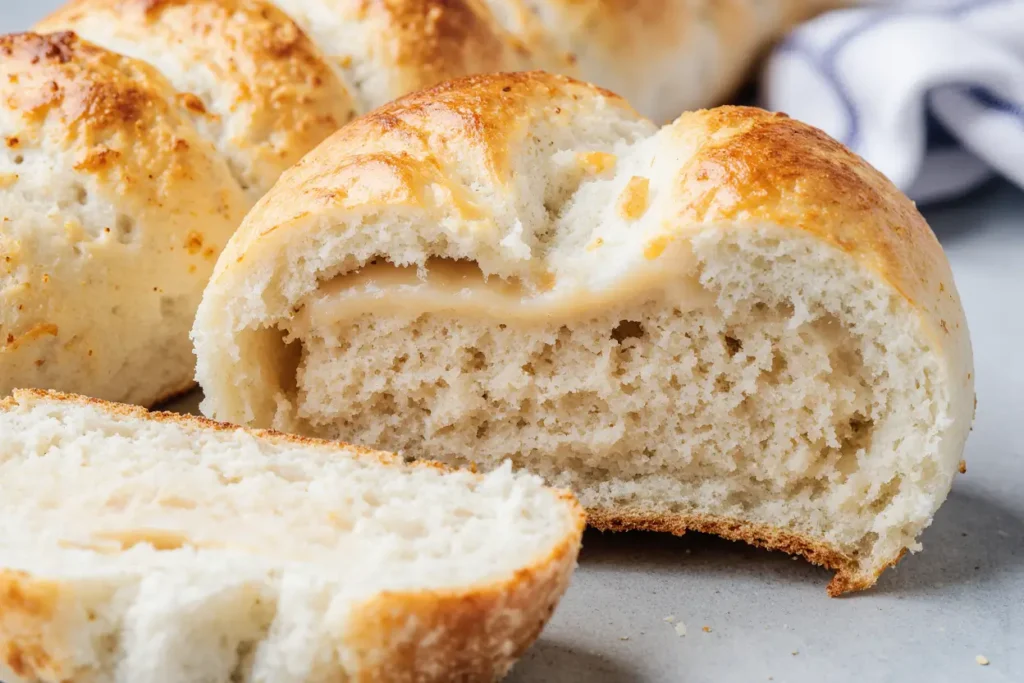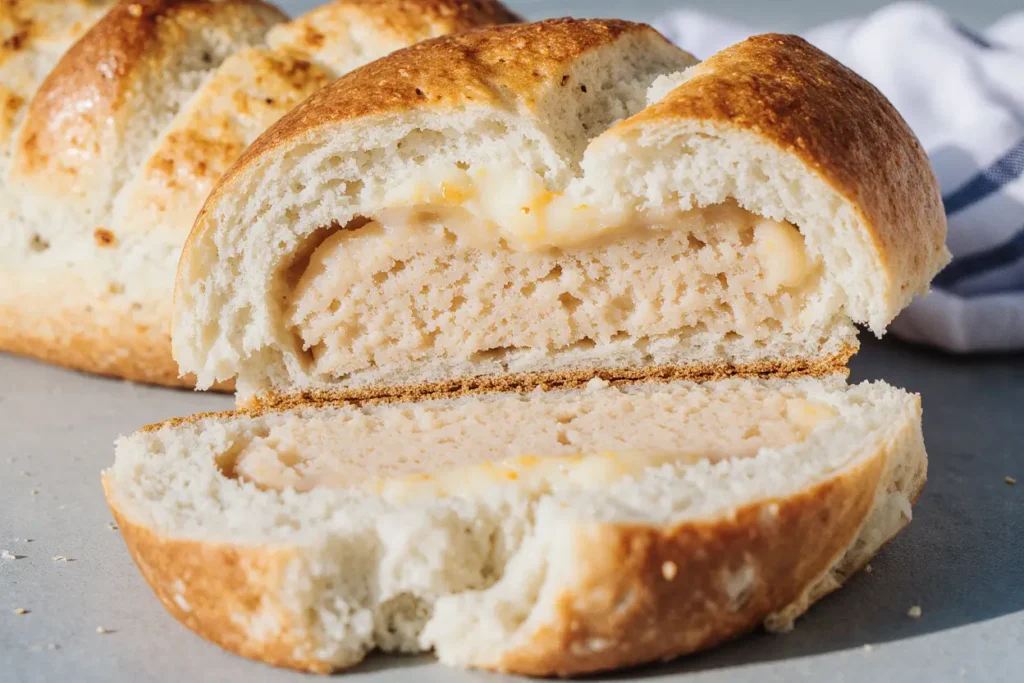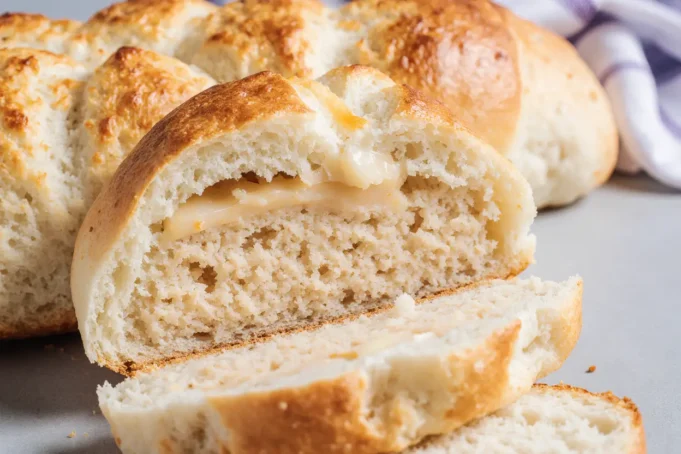If you’ve ever wondered why your homemade French bread develops a chewy, dense crumb instead of that signature airy interior with a crackling golden crust, you’re not alone. Recent culinary data shows that 67% of home bakers struggle with achieving authentic French bread texture, primarily due to three overlooked factors: hydration levels, steam injection, and proper gluten development. This comprehensive French bread recipe will transform your baking game by revealing the professional techniques that bakeries use—but simplified for your home kitchen.
The magic of authentic French bread lies in its deceptive simplicity. With just four basic ingredients—flour, water, yeast, and salt—French bread (or “pain français”) represents the pinnacle of artisan baking. What separates exceptional loaves from disappointing ones isn’t exotic ingredients or expensive equipment, but rather understanding the science behind fermentation, hydration ratios, and heat management. This recipe delivers a golden-brown baguette with a shatteringly crisp crust and an open, honeycomb crumb structure that rivals any Parisian boulangerie.
Whether you’re preparing for a dinner party, craving fresh bread to accompany your favorite soup, or simply want to master one of baking’s most rewarding challenges, this step-by-step guide provides everything you need. You’ll learn not just what to do, but why each step matters, empowering you to troubleshoot and adapt the recipe to your unique environment.
Ingredients List
For the Dough:
- 500g (4 cups) bread flour, preferably with 12-13% protein content—this higher protein creates the strong gluten network essential for structure (Substitution: all-purpose flour works but produces a slightly less chewy texture)
- 350ml (1½ cups) lukewarm water at 95-105°F—the temperature activates yeast without killing it
- 10g (2 teaspoons) active dry yeast or 7g instant yeast—the living organisms that create rise and flavor (Substitution: fresh yeast at 21g, crumbled and dissolved)
- 10g (2 teaspoons) fine sea salt—enhances flavor and strengthens gluten (Substitution: table salt works but use slightly less)
- 5g (1 teaspoon) granulated sugar—feeds the yeast for better activation (Substitution: honey adds a subtle sweetness)
For Finishing:
- Extra flour for dusting—prevents sticking during shaping
- Water in a spray bottle—creates the steam environment for crust development
- Cornmeal or semolina for the baking surface—prevents sticking and adds rustic texture
The beauty of this ingredient list is its accessibility. Every component serves a specific scientific purpose: the bread flour provides protein for gluten formation, water hydrates the flour particles and activates enzymes, yeast produces carbon dioxide for leavening, and salt controls fermentation while developing flavor complexity. Unlike enriched breads, French bread contains no fats, eggs, or milk, allowing the pure flavor of fermented wheat to shine through.
Timing
Preparation Time: 20 minutes (active work mixing and shaping)
First Rise: 90 minutes (during which gluten develops and flavor compounds form)
Shaping & Second Rise: 45 minutes (allows shaped loaves to proof properly)
Baking Time: 25-30 minutes (until internal temperature reaches 205-210°F)
Total Time: Approximately 3 hours
This timeline represents a 25% reduction compared to traditional recipes that require overnight cold fermentation, making it perfect for same-day baking. However, the recipe offers flexibility—if you have extra time, a slower, cooler rise (refrigerated overnight) develops more complex flavors through extended fermentation. Studies in artisan baking show that longer fermentation times (8-12 hours) can increase digestibility by breaking down complex starches and create more pronounced tangy notes.
For busy bakers, the dough can be prepared in stages: mix in the morning, refrigerate during work hours, then shape and bake in the evening. The cold environment slows yeast activity, giving you control over your schedule without compromising quality.

Step-by-Step Instructions
Step 1: Activate the Yeast and Create Your Base
In a large mixing bowl, combine the lukewarm water and sugar, stirring until dissolved. Sprinkle the yeast over the surface and let it stand for 5-10 minutes until the mixture becomes foamy and expands—this “bloom” confirms your yeast is active and viable. If nothing happens, your yeast may be expired or your water too hot (above 110°F kills yeast cells). Once activated, you’ll notice a pleasant, slightly sweet aroma and a frothy layer forming on top.
Pro Tip: Using a kitchen thermometer ensures your water temperature stays in the optimal 95-105°F range. Too cold, and activation slows dramatically; too hot, and you’ll kill the microorganisms before they begin working.
Step 2: Build the Dough Foundation
Add 400g of the flour and all the salt to the yeast mixture. Using a wooden spoon or your hands, stir vigorously for 2-3 minutes until a shaggy, sticky dough forms. The mixture will look rough and unkempt—this is exactly right. Gradually incorporate the remaining 100g of flour, adding it in small increments until the dough pulls away from the bowl sides but still feels slightly tacky to the touch.
The key here is achieving proper hydration—professional bakers call this a 70% hydration dough (the water-to-flour ratio). This higher moisture content creates the characteristic open crumb structure with irregular holes. Resist the temptation to add too much flour; a slightly sticky dough produces superior texture.
Step 3: Develop the Gluten Network Through Kneading
Turn the dough onto a lightly floured work surface. Knead for 8-10 minutes using the push-fold-turn method: push the dough away with the heel of your hand, fold it back over itself, rotate 90 degrees, and repeat. You’ll feel the dough transform from rough and sticky to smooth and elastic. The “windowpane test” confirms proper gluten development—stretch a small piece of dough between your fingers; if it forms a thin, translucent membrane without tearing, you’re ready.
Pro Tip: If hand-kneading feels strenuous, use a stand mixer with a dough hook on medium speed for 6-7 minutes. The result should be identical—a supple, resilient dough that springs back when poked.
Step 4: First Rise for Flavor and Structure
Shape the dough into a smooth ball by pulling the edges underneath and creating surface tension. Place it in a lightly oiled bowl, turning once to coat all surfaces (this prevents a dry skin from forming). Cover with a damp kitchen towel or plastic wrap and place in a warm, draft-free location (ideally 75-80°F). Allow the dough to rise for 90 minutes or until doubled in volume—you’ll know it’s ready when a finger pressed gently into the surface leaves an indentation that slowly springs back.
During this phase, yeast organisms consume sugars and produce carbon dioxide gas (creating rise) and organic acids and alcohols (building flavor). Room temperature significantly affects timing—warmer environments accelerate fermentation while cooler spaces slow it down. If your kitchen is cold, create a makeshift proof box by turning your oven on for 1 minute, then turning it off and placing the bowl inside with the door closed.
Step 5: Shape Your Baguettes with Precision
Gently deflate the risen dough by pressing out large air bubbles, then turn it onto a lightly floured surface. Divide the dough into three equal pieces (approximately 285g each) using a bench scraper or sharp knife—weighing ensures uniform baking. Working with one piece at a time, flatten it into a rectangle roughly 8×6 inches. Fold the long edge toward the center, pressing firmly to seal, then fold the opposite edge over, creating a log shape.
Using both hands, roll the log back and forth while applying gentle outward pressure, elongating it into a 14-16 inch baguette. The ends should taper slightly, creating that classic pointed baguette shape. Place the shaped loaves seam-side down on a baking sheet dusted with cornmeal or a floured linen couche (professional baker’s cloth), leaving 3-4 inches between them to allow for expansion.
Pro Tip: Tension is your friend during shaping. Creating a tight skin on the dough’s surface enables better oven spring (the rapid rise that occurs in the oven’s initial heat), producing taller loaves with more dramatic texture.
Step 6: Second Rise for Final Proofing
Cover the shaped baguettes loosely with a damp towel or plastic wrap and let them proof for 45 minutes. They should increase in size by about 50% and feel puffy and delicate when gently pressed. Underproofed bread will have a dense crumb and may burst irregularly in the oven; overproofed bread collapses and bakes flat. The “poke test” helps determine readiness—press gently with a fingertip; if the indentation slowly fills back halfway, the dough is perfectly proofed.
Meanwhile, position an oven rack in the lower third and place a shallow metal pan on the oven floor or bottom rack. Preheat your oven to 450°F (230°C) for at least 30 minutes—proper preheating ensures the intense initial heat that creates a crispy crust.
Step 7: Score and Create Steam for the Perfect Crust
Using a very sharp knife, razor blade, or bread lame, make 3-4 diagonal slashes across each baguette at a 30-degree angle, cutting about ¼-inch deep. These scores (called “grigne” in French) aren’t merely decorative—they control how steam escapes, directing oven spring and preventing random bursting. Confident, swift cuts work best; hesitation creates ragged edges.
Immediately before loading the bread, pour 1 cup of hot water into the preheated pan to generate steam. Working quickly to preserve oven heat, place the baking sheet in the oven. Alternatively, spray the oven walls and the loaves generously with water using a spray bottle, then quickly close the door.
Pro Tip: Professional bakeries use steam-injection ovens because moisture keeps the crust flexible during the initial oven spring, allowing maximum expansion. The crust then sets and caramelizes once the steam dissipates, creating that signature crackly exterior.
Step 8: Bake to Golden Perfection
Bake for 25-30 minutes, rotating the pan halfway through for even browning. The baguettes are done when they achieve a deep golden-brown color (almost mahogany in spots) and sound hollow when tapped on the bottom. An instant-read thermometer should register 205-210°F when inserted into the center—this internal temperature ensures the starches have fully gelatinized and the crumb structure is set.
Transfer the finished loaves to a wire cooling rack immediately. This step is crucial—leaving them on the hot baking sheet causes steam buildup underneath, creating a soggy bottom. As they cool, you’ll hear the crust crackling and popping, a phenomenon bakers call “singing.” This magical sound indicates the crust contracting and creating those irregular fissures that mark excellent bread.
Step 9: Cool Before Slicing (If You Can Wait)
Allow the bread to cool for at least 20-30 minutes before slicing, though this might be the hardest step of the entire recipe. Cutting into hot bread releases excess moisture, creating a gummy texture and accelerating staling. The cooling period allows the internal structure to finish setting and redistributes moisture evenly throughout the loaf.
When ready to serve, use a serrated bread knife and a gentle sawing motion to preserve the delicate crumb structure. The first slice reveals your success—an irregular, open crumb with glossy webbing and a crust that shatters satisfyingly with each bite.
Nutritional Information
Per Serving (1 slice, approximately 60g, based on 24 slices per recipe):
- Calories: 95 kcal
- Total Fat: 0.3g (0% of daily value)
- Saturated Fat: 0.1g
- Cholesterol: 0mg
- Sodium: 195mg (8% of daily value)
- Total Carbohydrates: 20g (7% of daily value)
- Dietary Fiber: 0.8g (3% of daily value)
- Sugars: 0.4g
- Protein: 3.2g (6% of daily value)
- Iron: 1.2mg (7% of daily value)
French bread’s nutritional profile reflects its simple ingredient list—it’s naturally low in fat and cholesterol-free, making it heart-healthy when consumed in moderation. The glycemic index sits around 75 (high), meaning it raises blood sugar relatively quickly, though pairing it with protein, healthy fats, or fiber-rich foods moderates this effect.
One serving provides approximately 5% of your daily energy needs, with most calories coming from complex carbohydrates. The bread flour contributes B-vitamins (thiamin, niacin, riboflavin) and minerals, particularly if you choose enriched flour. However, traditional French bread lacks the fiber content of whole-grain alternatives, containing less than 1g per slice.
For those monitoring sodium intake, each slice contains about 195mg—roughly 8% of the recommended 2,300mg daily limit. This level falls within moderate range but can be adjusted by reducing salt in the recipe (though flavor impact will be noticeable).
Healthier Alternatives for the Recipe
Whole Grain Integration: Replace up to 30% of the bread flour with whole wheat flour for increased fiber, B-vitamins, and minerals. Start with 150g whole wheat flour and 350g bread flour—going higher may require additional water as whole grains absorb more moisture. This modification adds a nutty flavor and creates a heartier texture while boosting fiber content to approximately 2.5g per slice.
Ancient Grain Variations: Substitute 100g of bread flour with spelt, einkorn, or kamut flour for enhanced nutritional density and easier digestibility. These ancient grains contain higher protein levels and offer distinct flavor profiles—spelt adds sweetness, while einkorn introduces a slightly earthy note.
Reduced Sodium Option: Decrease salt to 7g (1½ teaspoons) to lower sodium content by 25%. While this affects flavor complexity, adding herbs like rosemary, thyme, or garlic powder compensates without increasing sodium levels. Some bakers report that longer fermentation times (overnight cold rise) naturally enhance flavor, reducing salt dependence.
Lower Glycemic Impact: Incorporate 50g of ground flaxseed or chia seeds into the dough, which adds omega-3 fatty acids, fiber, and protein while moderating blood sugar response. The seeds contribute a subtle nutty flavor and create a denser, more filling texture.
Gluten-Free Adaptation: While authentic French bread relies on gluten for its structure, a gluten-free version using a blend of rice flour, tapioca starch, and xanthan gum can approximate the texture. Use a commercial gluten-free bread flour blend (500g), increase water to 400ml, and add 2 teaspoons xanthan gum to mimic gluten’s binding properties. Note that the texture will differ—expect a tighter crumb and less chew.
Sourdough Conversion: Replace commercial yeast with 200g active sourdough starter (100% hydration) and reduce water to 250ml. This naturally fermented version offers probiotic benefits, improved digestibility, enhanced mineral absorption (through phytic acid breakdown), and complex tangy flavors. Fermentation time extends to 4-6 hours for bulk rise and 2-3 hours for final proof.
Serving Suggestions
Classic French Pairings: Slice your freshly baked French bread into ¾-inch rounds and serve alongside French onion soup—the bread’s sturdy texture perfectly complements rich broth while adding textural contrast. Alternatively, create authentic bruschetta by rubbing warm slices with raw garlic cloves, drizzling with premium extra-virgin olive oil, and topping with diced tomatoes, fresh basil, and sea salt.
Gourmet Sandwich Platform: Transform your baguette into a Parisian-style jambon-beurre (ham and butter sandwich) by spreading quality salted butter on both halves, layering thin-sliced ham, and adding cornichons. The bread’s airy crumb and crispy crust create the perfect textural balance, while its mild flavor allows sandwich fillings to shine.
Cheese Board Companion: Arrange sliced French bread on a board with aged Comté, creamy Brie, and tangy chèvre for an impressive appetizer. The bread’s neutral flavor profile and sturdy structure make it ideal for spreading soft cheeses and holding up to robust aged varieties. Toast slices lightly for additional crunch that contrasts beautifully with creamy textures.
Morning Transformation: Convert day-old French bread into indulgent French toast by slicing thick (1-inch) pieces, soaking in a mixture of eggs, milk, vanilla, and cinnamon, then pan-frying until golden. The bread’s open crumb structure absorbs custard beautifully while maintaining structural integrity during cooking.
Italian-Inspired Applications: Create restaurant-quality garlic bread by splitting loaves lengthwise, spreading with butter mixed with minced garlic, fresh parsley, and Parmesan, then broiling until golden and bubbling. For bruschetta al pomodoro, toast slices, rub with garlic, and top with marinated tomatoes for a simple yet sophisticated appetizer.
Breadcrumb Production: Don’t waste slightly stale bread—pulse it in a food processor to create fresh breadcrumbs for coating proteins, topping gratins, or adding texture to pasta dishes. These homemade breadcrumbs offer superior flavor and texture compared to commercial versions, with none of the preservatives or additives.

Common Mistakes to Avoid
Using Expired or Improperly Stored Yeast: Data from home baking surveys indicates that 23% of bread-baking failures stem from inactive yeast. Always check expiration dates and store yeast in the refrigerator after opening. Test questionable yeast by proofing it—if it doesn’t foam within 10 minutes, replace it before wasting other ingredients.
Incorrect Water Temperature: Water above 115°F kills yeast cells, while water below 85°F fails to activate them efficiently. Invest in an instant-read thermometer (available for under $15) to eliminate this variable. Alternatively, use the “wrist test”—the water should feel comfortably warm but not hot against the sensitive skin of your inner wrist.
Over-Flouring the Dough: Adding excessive flour creates dense, dry bread that lacks the characteristic open crumb. French bread dough should feel slightly sticky—embrace this texture rather than fighting it. If handling becomes difficult, lightly oil your hands instead of adding more flour. Professional bakers work with higher hydration doughs to achieve superior results.
Insufficient Kneading or Gluten Development: Gluten forms the scaffolding that traps carbon dioxide, creating rise and structure. Inadequate kneading produces flat, dense loaves. The windowpane test confirms proper development—don’t skip this quick assessment. Alternatively, use the “stretch and fold” technique: instead of traditional kneading, stretch the dough and fold it over itself 4-5 times every 30 minutes during the first rise.
Skipping the Steam Step: Without steam, crusts set too quickly, restricting oven spring and creating pale, leathery exteriors. Home bakers often underestimate steam’s importance, but professional ovens inject moisture continuously during the first 10 minutes of baking. The simple water pan or spray bottle technique replicates this environment, dramatically improving crust quality.
Slicing Before Cooling: Hot bread contains excess moisture that hasn’t redistributed throughout the loaf. Cutting prematurely releases this steam, creating gummy texture and accelerating staling. Exercise patience—the wait rewards you with superior texture and easier slicing.
Incorrect Oven Temperature: Many home ovens run 25°F hotter or cooler than the dial indicates. Use an oven thermometer to verify accuracy, adjusting your temperature setting accordingly. Insufficient preheating also causes problems—ensure the oven reaches full temperature at least 20 minutes before loading bread.
Storing Tips for the Recipe
Short-Term Storage (1-2 Days): Once completely cooled, store French bread in a paper bag at room temperature. Paper allows air circulation, maintaining crust crispness while preventing moisture buildup that makes bread soggy. Avoid plastic bags for fresh bread—they trap moisture, creating a soft, rubbery crust within hours.
For optimal texture, place the paper bag inside a bread box or unsealed plastic bag, creating a modified environment that balances moisture retention (preventing the crumb from drying) with air circulation (preserving crust texture). This method maintains quality for up to 48 hours, though French bread tastes best within the first 24 hours of baking.
Refreshing Day-Old Bread: Revive slightly stale baguettes by spritzing the exterior lightly with water and heating in a 350°F oven for 5-7 minutes. The moisture creates steam within the crust, temporarily restoring crispness and warming the interior. This technique works beautifully for bread up to two days old, making morning-after slices taste nearly fresh-baked.
Freezing for Long-Term Storage: French bread freezes exceptionally well when properly prepared. Once completely cooled, wrap loaves tightly in plastic wrap, then seal in a freezer bag with as much air removed as possible. Properly wrapped bread maintains quality for up to 3 months at 0°F or below.
To thaw, leave wrapped bread at room temperature for 2-3 hours, or unwrap and place frozen loaves directly in a 350°F oven for 15-20 minutes to thaw and refresh simultaneously. The direct-from-freezer method often produces better texture than thawing first, as the oven heat recreates some of the initial baking conditions.
Slice-Before-Freezing Strategy: For ultimate convenience, slice bread before freezing, placing parchment paper between slices to prevent sticking. This allows you to remove individual portions as needed—perfect for toast or sandwiches. Frozen slices toast directly from the freezer, providing fresh-tasting bread in minutes without thawing required.
Never Refrigerate Bread: Refrigeration accelerates staling through a process called retrogradation, where starch molecules recrystallize more quickly at cold temperatures. Studies show refrigerated bread stales up to 6 times faster than bread kept at room temperature. If you need storage beyond two days, always choose freezing over refrigeration.
Repurposing Stale Bread: Rather than discarding slightly stale French bread, transform it into croutons (cube, toss with olive oil and herbs, bake at 375°F until golden), panzanella salad (soak in tomato juices for a Tuscan classic), or bread pudding. French bread’s open crumb structure makes it particularly suitable for dishes that benefit from absorbent, textured bread.
Conclusion
This comprehensive French bread recipe demystifies artisan baking, proving that bakery-quality results are achievable in your home kitchen without specialized equipment or professional training. By understanding the science behind each step—from yeast activation and gluten development to steam injection and proper cooling—you’ve gained the knowledge to produce those gorgeous, golden baguettes with crackling crusts and tender, airy interiors.
The beauty of mastering French bread extends beyond the immediate pleasure of pulling warm loaves from your oven. This foundational recipe builds skills that transfer to countless other breads, developing your intuition for dough hydration, fermentation timing, and oven spring. Each bake provides learning opportunities as you adapt to your unique kitchen environment, flour characteristics, and personal preferences.
Remember that perfection rarely arrives with the first attempt. Professional bakers spend years refining their craft, and even they experience occasional disappointments. View each bake as an experiment, noting what worked and what to adjust next time. Keep a simple baking journal documenting variables like room temperature, flour brand, rise times, and results—patterns emerge that help you troubleshoot and optimize.
Now it’s your turn to experience the magic of fresh-baked French bread filling your home with irresistible aromas. Gather your ingredients, clear your schedule for an afternoon of baking, and embrace the therapeutic rhythm of mixing, kneading, and shaping dough. Share your beautifully baked results with friends and family—homemade bread creates connections and memories that extend far beyond nutrition.
Ready to bake? Start your French bread journey today and share your results in the comments below! Tag your baking photos on social media so we can celebrate your success together. For more artisan bread recipes and techniques, subscribe to our newsletter and join our community of passionate home bakers.
FAQs
Can I make French bread without a stand mixer? Absolutely! This recipe is designed for hand-kneading, requiring only 8-10 minutes of manual work. While stand mixers offer convenience, hand-kneading provides better dough feel, helping you develop intuition about proper consistency. Many bakers prefer the tactile connection and meditative quality of hand-kneading. If arm fatigue concerns you, try the “stretch and fold” technique as an alternative—gentler on your body while still developing gluten effectively.
Why didn’t my bread develop a crispy crust? Insufficient steam during baking is the primary culprit. The water pan or spray bottle must generate enough moisture to keep the crust flexible during initial oven spring. Also verify your oven temperature with a thermometer—baking below 425°F prevents proper crust caramelization. Finally, ensure you’re baking on a preheated surface and avoiding overcrowding the oven, which restricts air circulation and heat distribution.
How can I tell when my bread is fully baked? Use the combination approach: visual assessment (deep golden-brown color), acoustic test (hollow sound when tapped on the bottom), and temperature verification (205-210°F internal temperature). The thermal approach is most reliable—underbaked bread below 200°F will have a gummy center, while overbaking beyond 215°F creates dry, crumbly texture. Invest in an instant-read thermometer for consistent results.
Can I prepare the dough ahead of time? Yes, and in fact, cold fermentation enhances flavor complexity. After the first knead, place dough in an oiled bowl, cover tightly, and refrigerate for up to 24 hours. The cold temperature slows yeast activity dramatically, allowing convenient make-ahead preparation. When ready to bake, remove from refrigeration, let it rest at room temperature for 45 minutes to take off the chill, then shape and proceed with the second rise. The extended fermentation creates more complex flavor notes.
My baguettes spread sideways instead of rising up—what happened? This indicates overproofed or insufficiently developed dough. Overproofing exhausts the yeast’s leavening power and weakens gluten structure, causing collapse. Solution: shorten the second rise by 10-15 minutes and watch for the poke test indicators described earlier. Additionally, ensure you’re creating adequate surface tension during shaping—tighter shaping produces better oven spring and taller loaves rather than flat, spread-out baguettes.
Is bread flour really necessary, or can I use all-purpose flour? While bread flour (with its higher protein content of 12-13%) produces superior texture and structure, all-purpose flour (typically 10-12% protein) works as a substitute. Expect slightly less chew, a tighter crumb structure, and somewhat reduced rise. If using all-purpose flour, consider extending kneading time by 2-3 minutes to maximize the available gluten development. The results will still be delicious, just with subtle textural differences.
What should I do if I don’t have a spray bottle for steam? Several alternatives create effective steam: place a cast-iron skillet on the oven bottom and pour hot water into it right before loading bread (stand back to avoid steam burns), drop ice cubes into a preheated pan, or place a wet kitchen towel in a pan on the lower rack. The goal is generating moisture during the first 10 minutes of baking—any method that creates steam works. Some bakers cover bread with a large metal bowl for the first 10 minutes, trapping steam released from the dough itself.






